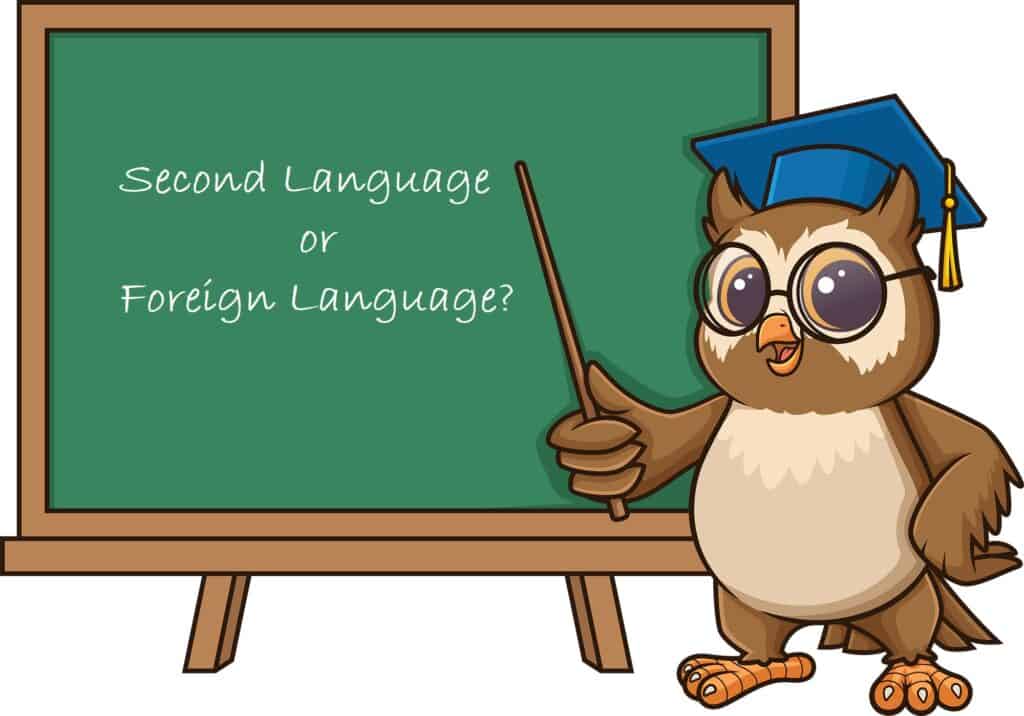
There are different terms to describe our spoken language(s). What does it mean to have a second language versus learning a foreign language? These terms are commonly used interchangeably and most times without issue, but they refer to different concepts.
The difference between a second language and foreign language is based on usage. Second languages designate communication with those in the immediate or extended community. It is not native, but commonly used. Conversely, a foreign language has no direct link to the social or personal environment.
While this vocabulary is typically used interchangeably, and is generally understood anyway, it can be helpful at times to be clear about the concepts. Read further to learn the difference between having a second language versus learning a foreign language and what the implications are for each in how the language is used.
Contents
Defining Our First Language
Before delving into the subtleties between a second and foreign language, we need to define “the first language” to set the foundation for understanding the difference between a second or foreign language.

As babies, we acquire a first language. We refer to this as our ““mother tongue” because it is the language we learn as infants from our mothers. It is often also referred to as our native language. This is the only or primary language spoken in our home. In scholarly text, it’s called L1.
Often (but not always), this is the language spoken by our:
- Neighbors
- Friends
- Teachers
- Other community members
It is our primary mode of communication from birth throughout the rest of our lives,, and it gives meaning to:
- Objects
- Actions
- Concepts
We don’t usually think about our primary language as communication mainly because we use it to think. It makes it difficult for us to grasp. We tend to simply accept it as always being there.
This is one of the reasons that second or foreign language learning is difficult for many to fully reach. We need to first be able to analyze our original mode of communication in order to acquire another. For some, it feels a bit like mental gymnastics.
What It Means to Speak a Second Language

Often, we refer to the L2 as any language learned or acquired after our L1 or first language, meaning a person knows two languages fluently. However, a true definition of a person’s second language is established when they learn a second language that is widely used in their geographic region to function in society.
Learning a second language is necessary in most cases, if their first language is not the primary language spoken in public by most citizens in the region. There are various reasons a second language is learned and different ways it functions in one’s life.
Normally, it is a language learned as a tool for effective communication in the following public venues:
- Work or trade
- Higher education
- Administration
The second language is usually learned by school age and used throughout the learner’s lifetime to communicate fluidly with their peers but can also be learned later in life.
For example, as a public school teacher and language specialist, I worked with many newcomers to the United States to teach them a second language (English) so that they could function within our schools successfully. When my students went home, they most always resorted to their mother tongue with their family.
This can also happen in countries like Mexico where there is a large indigenous population that for many reasons only speak dialects and versions of their native languages. With the official language of Mexico being Spanish, many of the children of these families will at one point in their lives have to learn to communicate with Spanish speakers.
Second Language Acquisition versus Second Language Learning
A second language can be acquired or learned. As with the terms “second language” versus “foreign language”, people often use “second language acquisition” interchangeably with “second language learning.” But again, the processes are not the same, even if they’re generally referring to the same concept.
In 1982, Linguist Researcher and Educator, Stephen Krashen, shared his ideas of Second language acquisition (SLA) and defined five gradual stages towards fluency. SLA is the process of acquiring a language through being exposed to the language in daily interactions in places such as:
- The park or recreational places
- Market place
- Workplace
- School
There is little or no formal training involved in the acquisition as it is picked up through exposure to other people and the environment. It is acquired through immersion. And this is basically how L1 or your first language is acquired.
Children can acquire a second language (I’ve linked to a detailed article I’ve written about children and acquisition) more rapidly than adults due to both cognitive and environmental factors.
The first is that young children’s brains are still forming neural connections at a fast pace. This slows down in adulthood. The neural pathways that are regularly used are reinforced and strengthened.
As children learn and grow into adulthood, they can easily access the information from these robust neural pathways.
The second reason children acquire language more quickly than adults is that they aren’t trying to learn the language but rather are absorbing it through direct contact.
Children have less distractions in their lives, such as:
- Work
- Paying Bills
- Childcare
They are free to focus on playing and learning and can put all of their mental effort into those things.
Children are also less inhibited and don’t worry as much about making mistakes. They learn from their mistakes.
None of this means that adults cannot also acquire or absorb language, just that the earlier language is acquired, the stronger and more efficient the process is.
How Second Language Learning Differs from Acquisition

On the other hand, second language learning (SLL) occurs in a structured, formal setting such as a classroom.
The language learner may have missed out on opportunities to acquire meaning from being exposed to the language in authentic ways through their environment. As a result, they have to make a more concerted effort at learning the language.
This can be done by seeking out opportunities for authentic learning by immersing themselves in community and cultural activities where the language is widely used.
Speaking a Second Language as a Cultural Norm
In many countries around the world, there is more than one language that is widely used within specific:
- Geographical regions in the country
- Ethnic or cultural groups
- Religious groups
- Socioeconomic groups
The second language is necessary because the mother tongue may not be used as frequently outside of the home. Usually, a bilingual person is less fluent in their second language than their first language.
Speaking a second language facilitates the speakers’ integration into any of the groups listed above to communicate and fully participate in group activities.
Common Examples of Second Languages Used in Countries Around the Globe
In many countries outside of the United States, most people are bilingual or even multilingual because they are fluent in at least one language in addition to their mother tongue. Sorry, but I can’t resist sharing this US trilingual representation t-shirt (from Amazon) for a bit of side humor!
Second languages are usually a byproduct from former or current European colonies that occupied a geographic area. English is the most common second language used in the world, followed respectively by:
- French
- Russian
- Spanish
- Creole
- Arabic
- Kurdish
- Portuguese
- Italian
- Quechua
The table below includes examples of second languages used in different countries. I’ve written more about this here.
| Country | Official Language | Common Second Language(s) |
| United States | English | Spanish, Chinese |
| Canada | English | French |
| Algeria, Morocco, Tunisia | Arabic | French |
| India | Hindi | English |
| Bangladesh | Bengali | English |
| Pakistan | Urdu | English |
| Australia | Unofficially English | Mandarin, Arabic, Cantonese, Vietnamese, Italian, Greek, Hindi, Spanish, Punjabi |
| China | Mandarin | Cantonese, Shanghainese, Fuzhou |
If you have ever traveled to Europe it becomes immediately apparent that multiple languages are a part of people’s everyday life. It is not uncommon for people to switch fluidly in an out of several languages in a single conversation or interaction.
What Does It Mean To Learn a Foreign Language

Even though many people use second and foreign interchangeably when referring to language learning (admittedly, even I, a language specialist, often do for ease and convenience), they are technically a bit different. A foreign language is defined as a language that is not widely spoken by the people of a:
- Community
- Society
- Nation
The language in question is not generally used in a specific region. For example, English is a second language in India, but Portuguese is a foreign language there because it is not commonly, if ever, used by any native demographic groups.
Unlike in second language acquisition, a foreign language requires a structured curriculum and a concerted effort to learn. People who take on a foreign language are often secondary education students or adults.
The reason for this is that true immersion is not possible in a foreign language. There are varying levels of simulated immersion that one can undertake, but they will always be a bit lacking in comparison for one reason or another.
How Are a Second and Foreign Language Similar?

The obvious similarity between a second language and a foreign language is that neither is the speaker’s first language or mother tongue.
Whether you have acquired a second language or have learned a foreign language, you have achieved the status of being bilingual or multilingual if you happen to speak more than two languages.
A third similarity exists when a second language is learned versus acquired through social interaction and the environment. Both a learned second language and foreign language require structure and a curriculum to develop a solid understanding of the language.
Finally, in general, the younger a person is, the more quickly they can pick up and retain either a second language or a foreign language.
The Differences Between Second and Foreign Languages
The difference depends on how the language is being used in that geographic region.
| Second Language | Foreign Language |
| Language is not the “mother tongue” of the speaker. | A language that is not generally, if ever, used in the speaker’s region. |
| Widely recognized and used in a particular region | Not widely used in the area where the speaker lives |
| Officially recognized and accepted as a language in the region | Not officially recognized where the speaker lives |
Final Talking Point on Second Language versus Foreign Language
While there are some similarities, there are easy distinctions that delineate what a second language is versus a foreign language.
A second language is often learned at a younger age for functional use in one’s community. English learners in the public school setting are learning a second language because it will help them function better in their new environment.
Adults often learn or acquire a second language by moving to a place where it’s spoken fluently. Basically, if an L2 is used outside the home commonly, then we can call that a second language.
People learn foreign languages so they can travel and communicate better or because they are personally interested in the language even though there are limited opportunities to use it outside the home. Sometimes people simply choose to learn a new language just for fun or personal fulfillment.
Whether you speak a second language or are learning a foreign language, you are considered to be bilingual or multilingual, and the benefits of being able to communicate with others are invaluable.
Additional References

